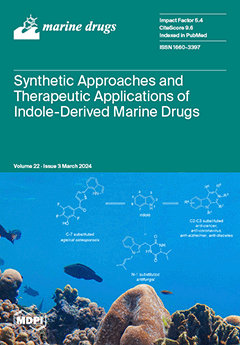Floridoside is a galactosyl–glycerol compound that acts to supply UDP-galactose and functions as an organic osmolyte in response to salinity in Rhodophyta. Significantly, the UDP-galactose pool is shared for sulfated cell wall galactan synthesis, and, in turn, affected by thallus development alongside carposporogenesis induced by volatile growth regulators, such as ethylene and methyl jasmonate, in the red seaweed
Grateloupia imbricata. In this study, we monitored changes in the floridoside reservoir through gene expression controlling both the galactose pool and glyceride pool under different reproductive stages of
G. imbricata and we considered changing salinity conditions. Floridoside synthesis was followed by expression analysis of
galactose-1-phosphate uridyltransferase (
GALT) as UDP-galactose is obtained from UDP-glucose and glucose-1P, and through
α-galactosidase gene expression as degradation of floridoside occurs through the cleavage of galactosyl residues. Meanwhile, glycerol 3-phosphate is connected with the galactoglyceride biosynthetic pathway by glycerol 3-phosphate dehydrogenase (G3PD), monogalactosyl diacylglyceride synthase (MGDGS), and digalactosyl diacylglyceride synthase (DGDGS). The results of our study confirm that low
GALT transcripts are correlated with thalli softness to locate reproductive structures, as well as constricting the synthesis of UDP-hexoses for galactan backbone synthesis in the presence of two volatile regulators and methionine. Meanwhile,
α-galactosidase modulates expression according to cystocarp maturation, and we found high transcripts in late development stages, as occurred in the presence of methyljasmonate, compared to early stages in ethylene. Regarding the acylglyceride pool, the upregulation of
G3PD,
MGDGS, and
DGDGS gene expression in
G. imbricata treated with MEJA supports lipid remodeling, as high levels of transcripts for
MGDGS and
DGDGS provide membrane stability during late development stages of cystocarps. Similar behavior is assumed in three naturally collected thalli development stages—namely, fertile, fertilized, and fertile—under 65 psu salinity conditions. Low transcripts for
α-galactosidase and high for
G3PD are reported in infertile and fertilized thalli, which is the opposite to high transcripts for
α-galactosidase and low for
G3PD encountered in fertile thalli within visible cystocarps compared to each of their corresponding stages in 35 psu. No significant changes are reported for
MGDGS and
DGDGS. It is concluded that cystocarp and thallus development stages affect galactose and glycerides pools with interwoven effects on cell wall polysaccharides.
Full article






